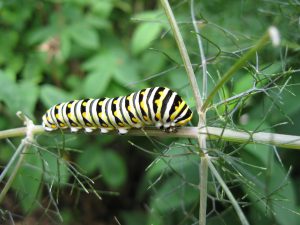Some of the cool season herbs can be used as food plants for many common butterfly caterpillars. Popular cool season herbs that double as caterpillar foods include parsley, fennel, dill, mint and rue.
Herb gardening is wildly popular among enthusiasts who like to eat what they grow or who enjoy the pleasant aromas of fresh herbs in their landscape. Herbs have a human connection far back into history and have been used as food garnishes and meal enhancers as well as medicines and potpourri.
For those enthusiasts who also love watching butterflies in their gardens and landscapes, some of the cool season herbs can be used as food plants for many common butterfly caterpillars. Popular cool season herbs that double as caterpillar foods include parsley, fennel, dill, mint and rue. Let’s take a look at some of the various butterflies and the herbs they love.

Black Swallowtail Butterflies
(Papilio polyxenes) seek out a variety of herbs on which to lay their eggs. Dill, fennel and parsley provide just the ticket for growing healthy caterpillars that will become delicate and beautiful adults. Starting out small and brown, these caterpillars become bright green with black and yellow stripes before making a chrysalis.
Giant Swallowtail Butterflies
(Papilio cresphontes) seek out rue plants on which to lay their eggs. Although rue isn’t considered a conventional culinary herb, it’s a popular herb planted by gardeners that will attract these large butterflies. Caterpillars of this species look like large bird droppings in an effort to avoid predators.
Gray Hairstreak Butterflies
(Strymon melinus) are one of the smaller visitors to the garden and seek out members of the mint family for nectar as well as food for their caterpillars. Mint can be invasive if allowed to get out of hand, but could be just the ticket for these diminutive beauties. Hairstreak caterpillars are small and green, looking almost like a little slug with a very fine coat of downy fuzz. They do not sting.
Many other herbs like rosemary, Echinacea, thyme and oregano are very attractive to a wide variety of butterflies for the nectar they provide. These cool season herbs are great for planting in fall and spring and a few of them have drought tolerant properties to boot!
So the question arises, “If I plant herbs and the caterpillars eat them, what’s left for me?” Simple solution: plant twice as much as you normally would so you get what’s needed for the kitchen and the caterpillars get what they need to become beautiful butterflies!




